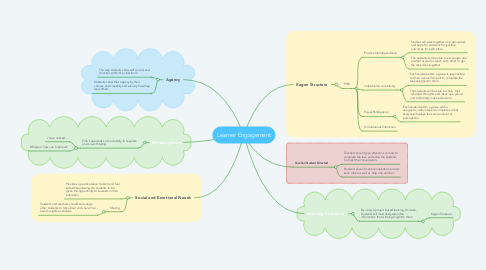
1. Kagen Structure
1.1. PIES
1.1.1. Positive Interdependence
1.1.1.1. Student will work together on a group task and hope for and work for positive outcomes for each other.
1.1.1.2. The students will be able to encourage one another as well as teach each other to get the task done together.
1.1.2. Individual Accountability
1.1.2.1. Each student within a group is responsible for their own certain part to complete the task assigned to them.
1.1.2.2. The students will be able to share their individual thoughts and ideas as a group and collectively make a decision.
1.1.3. Equal Participation
1.1.3.1. Each student within a group will be assigned a certain task to complete so that everyone displays the same amount of participation.
1.1.4. Simultaneous Interaction
2. Teacher/Student Directed
2.1. Teachers should give directions on how to complete the task and allow the students to direct the conversation.
2.2. Students should make conversation among each other as well as help one another.
3. Agency
3.1. The way students show self control and direction within the classroom.
3.2. Students show their agency by their choices and creativity and also by how they lead others.
4. Metacognition
4.1. One's awareness of and ability to regulate one's own thinking.
4.1.1. I have noticed...
4.1.2. Where or how can I improve?
5. Social and Emotional Needs
5.1. Provides a positive place to learn and feel safe while allowing the students to be given the opportunity to succeed in their education.
5.2. Sharing
5.2.1. Students and teachers should encourage other students to talk about and share their own thoughts and ideas.
6. Learning Retention
6.1. By using a project based learning structure, students will most likely retain the information that is being taught to them.
6.1.1. Kagen Structure
